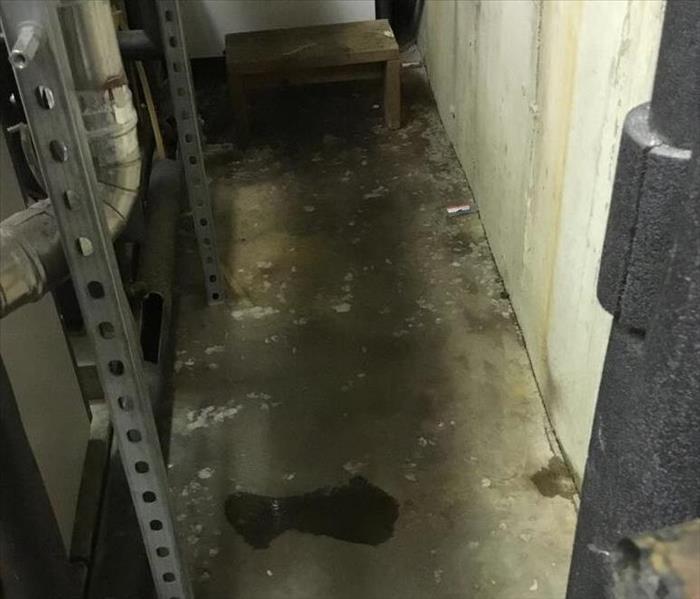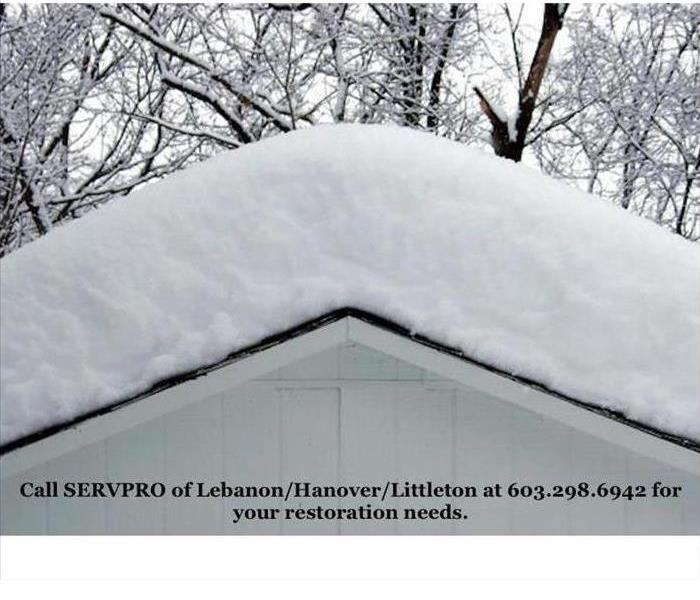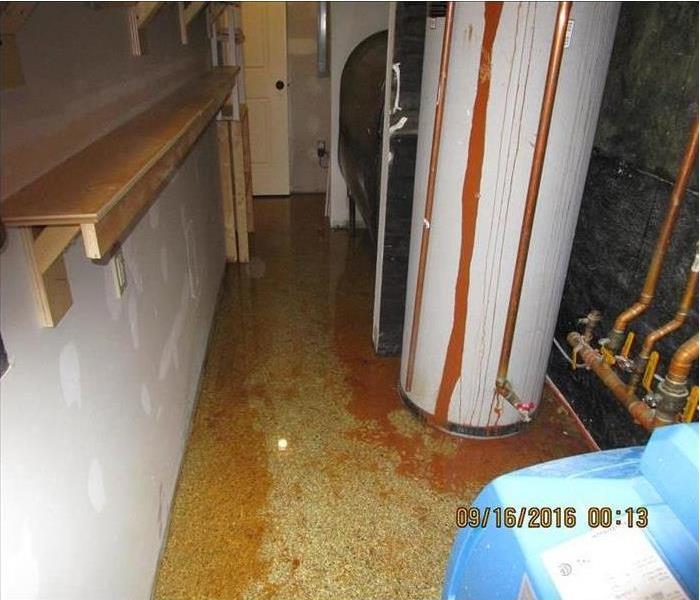Recent Water Damage Posts
Get ready for Winter
9/3/2024 (Permalink)
The weather is changing now! The cold temperatures are knocking on our door!
When we think about cold weather and how we can plan ahead; one thing often gets overlooked.
Our PIPES!
A burst pipe can create a big problem.Let's learn a little about burst pipes.
Some helpful tips on how to protect your pipes from freezing:
Burst pipes are one of the most common causes of property damage during frigid weather and can cause thousands in water damage.
Research conducted by the "Building Research Council at the University of Illinois" shows that the “temperature alert threshold” is 20° F, especially if you have uninsulated pipes running through an uninsulated space.
Here are some tips to help you keep those pipes in running order:
- Keep garage doors closed, especially if there are water supply lines in the garage.
- Open kitchen and bathroom cabinet doors to allow warmer air to circulate around the plumbing.
- Let the cold water drip from a faucet served by exposed pipes. Running water through the pipe—even at a trickle—helps prevent pipes from freezing.
- Keep the thermostat set to the same temperature during day and night. Again, during a cold snap is not the time to set back the thermostat at night to save a few bucks on your heating bill.
- If you plan to be away during cold weather, leave the heat on in your home, set to a temperature no lower than 55° F.
- For the long term, add insulation to attics, basements, and crawl spaces. Insulation will maintain higher temperatures in those areas. And to prevent drafts, seal cracks and openings around windows, doors, and at sill plates, where the house rests on its foundation.
Even with all of the preparations, pipes can freeze and burst leading to water damage. If you have any questions about how you can protect your pipes, give us a call today at 603-298-6942.
How do I know if there is water damage?
9/27/2023 (Permalink)
How to Check your home for Water Damage
Whether you've just been through a storm or are doing regular maintenance on your home, checking for water is always a good thing!
Don't wait until a BIG disaster happens!
Taking the time to complete the steps below periodically; Can save you from that big disaster and will keep that hard earned cash in your pocket!!
Step 1 - Check the Walls
The easiest sign of water damage to spot is water stains on the walls and ceilings. Also check around the window and door frames for stains.
Any unusual stains should be taken seriously, as they could be a sign of a leaky pipe or drain inside the wall.
Also look for cracks in the drywall and bubbling under the paint. An area of wall that has been exposed to water can also have a swollen appearance and be soft to the touch.
Step 2 - Check the Floors
Water damage can happen to any type of flooring and can also seep down to the sub floor.
Look for any warping or buckling of the floors, especially in the basement. If the floor looks warped, water damage is most likely the cause.
Step 3 - Check the Pipes
Inspect the piping in the kitchen, bathrooms, laundry room, and basement for corrosion around the pipe connections, leaks, or water stains.
Inspect the caulking around the bathroom fixtures. Missing or loose caulking could be caused by water seepage.
Look for missing grout or signs of mold. Check the water heater for wet spots on the floor and rust on the tank.
Step 4 - Check the Basement
Basement leakage is a common problem found in houses. Water in the basement often causes damage to the flooring, baseboards, walls, and furniture.
Additionally, odors caused by mold and mildew can be unpleasant and even cause health problems.
Inspect for cracks, stains, rust, dampness, mold, and odors. If you have drywall in your basement, Water can wick up it. Check all drywall for signs of water or water stains.
Step 5 - Check the Attic
Check the attic for stains, mold, and other signs of leaks.
Pay special attention to the valleys where 2 roof planes come together, the flashing where the roof meets the walls, and the flashing around roof vents and chimneys.
The insulation should be dry and in good condition. Houses located in cold climates can develop ice dams on the roof, which cause water to leak into the attic from melting snow and ice on the roof.
Also make sure that attic ventilation is sufficient.
Step 6 - Check the Exterior
Make sure to check the exterior of the house as well.
Check the roof for damaged flashing and missing, cracked, or curled shingles. If you see standing water anywhere outside the home, it could be the sign of a problem.
A puddle could be due to poor drainage in the yard, leaky rain gutters, or gutter spouts that don t take water far enough from the house.
The house should be situated on the highest point of the property, with the ground sloping away from the house.
If you see any signs of water damage in your home; call 1-603-298-6942 today. Don't let that small amount of water become a HUGE problem for you!
Common causes for water damage
6/30/2023 (Permalink)
THE 5 MOST COMMON CAUSES OF WATER DAMAGE IN YOUR HOME.
There are so many things that can damage your home. Wind,earthquakes,fires,storms and WATER.
Water Damage being the most frequent of all.
Here are the 5 most common causes of water damage in your home
Air Conditioner
Your air conditioner might seem to be working just fine, but it’s important to adhere to regular service dates (at least once each year) to ensure nothing is malfunctioning behind the scenes. Your A/C removes moisture from the air, and sometimes that moisture builds up within the A/C itself. If not properly drained, that water could be slowly leaking into your home – potentially ruining the flooring and drywall and, in many cases, introducing mold.
Dishwasher
Dishwashers are another possible culprit of water damage in your home. Your dishwasher can cause water damage if not properly sealed, meaning that the latch is broken, or if it was loaded with the wrong soap. Make sure that any leaks are immediately addressed and that your dishwasher is repaired or replaced ASAP.
Washing Machine
Perform regular checks on your washing machine, inspecting beneath the unit as well as behind it. Make sure all fittings are securely connected, and that the underbelly of the washing machine isn’t leaking any water beneath the unit. If you have an older washing machine that gives you frequent issues, consider replacing it altogether.
Leaking Pipes
It might seem obvious, but water damage in the home is often caused by leaky pipes. Let’s pretend that you have a loose-fitting pipe under the kitchen sink or in the bathroom, and you’ve just recently water pooling in that area. Don’t wait to call a plumber – a leak in one place in your home could signify leaks in other areas, too.
Clogged Drains
Clogged drains aren’t just annoying, they also cause water damage (and mold growth) if left unchecked. If your toilet is clogged, it means that not only can you not use the toilet, but you will likely also experience water backing up into the shower, sinks, or bathroom floor. Sewer water is extremely dangerous because it contains raw sewage and bacteria, and must be cleaned up by a professional.
If your kitchen sink drain is backing up, you can experience sink overflow and subsequent damages to your kitchen flooring and cabinetry. Make sure to seek professional help when experiencing frequent drain clogs so you don’t have to deal with water damage to your home on top of the clog itself.
If you are experiencing leaks in your home Call SERVPRO of Lebanon/Hanover/Littleton today at 603-298-6942.
When water becomes a hazard
9/21/2022 (Permalink)
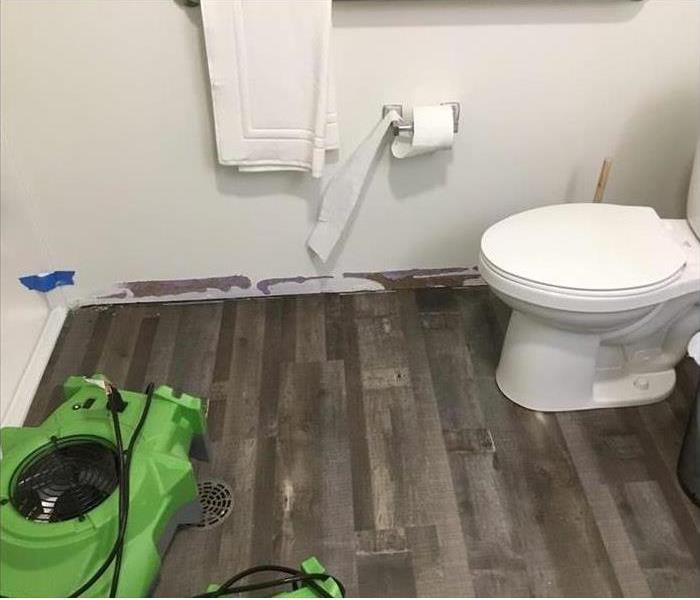 Water damage
Water damage
When water becomes a Bio Hazard!
Homeowners often don't realize that they are responsible for the maintenance and repair of their lateral sewer pipe which is the pipeline between the city sanitary sewer main (which is usually located in the street) and the building.
Sewer backups and toilet overflows can wreak havoc in your home and can create a bio hazard situation very quickly.
Sewage backup should be considered an emergency and dealt with as quickly as possible. We are the water damage restoration specialists with specific training and expertise to safely restore your home or business.
So, what are the most common causes of sewer backups?
In the Northeast we have many older homes, often times these homes can be over 100 years old and one of the causes of sewer backup is aging sewer systems.
The ASCE states that the nation's 500,000-plus miles of sewer lines are on average over thirty years old. This has caused and contributed to the rapid rise of sanitary sewer back ups, overflows and flooded basements.
Tree roots seeking moisture, small roots of trees and shrubs make their way into sewer line cracks and service pipe joints, they can cause extensive damage or blockages as they grow larger. The cost of the clean-up will fall to the problem tree's owner.
Combined pipelines cause problems to arise in systems that combine storm water and raw sewage into the same pipeline.
During many rain storms, the systems are exposed to more volume than they can handle, and the result is a sewage backup situation that allows sewage to spew out into basements and other low lying drains.
There are 3 categories of contaminated water that homeowners may have to deal with in a water leak or sewer back up scenario, they are:
Category 1: "Clean Water"
This is water from a clean source, such as a broken clean water supply line or faucet. If left untreated, category 1 water can quickly degrade into category 2 or 3 water depending upon such factors as time, temperature, and contact with contaminants.
Category 2: "Gray Water"
This water has a significant level of contamination. Sources for category 2 water may include washing machine overflow; toilet overflow with some urine, but no feces; or dishwasher overflow.
Category 3: "Black Water"
This water is grossly unsanitary and any contact should be avoided. Sources for category 3 water could include flooding from rivers or streams, water from beyond the toilet trap, water from the toilet bowl with feces, or standing water that has begun to support microbial growth.
Water can go from Category 1 to category 3 quickly if left untreated and exposed to bacteria.
Give us a call at 603-298-6942 if you are dealing with any water or sewer backup and we'll make it "Like it never even happened"
When water becomes a Bio Hazard!
6/15/2022 (Permalink)
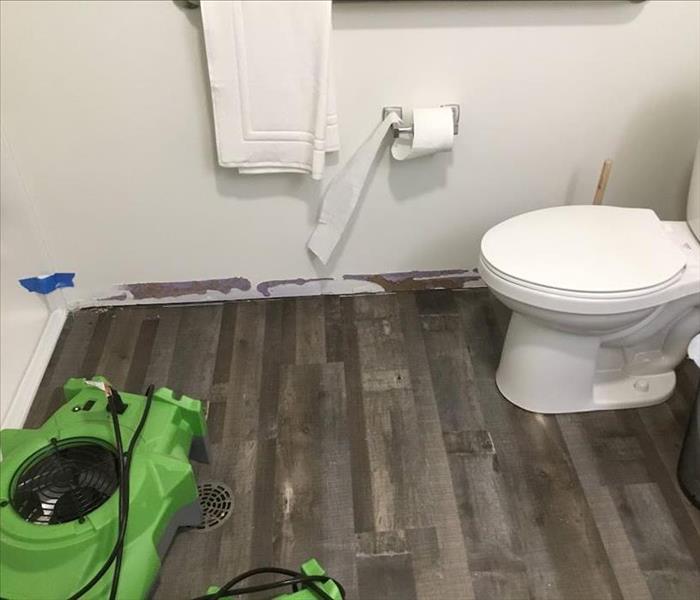 Sewer back ups can lead to a bio hazard situation quickly
Sewer back ups can lead to a bio hazard situation quickly
When water becomes a Bio Hazard!
Homeowners often don't realize that they are responsible for the maintenance and repair of their lateral sewer pipe which is the pipeline between the city sanitary sewer main (which is usually located in the street) and the building.
Sewer backups and toilet overflows can wreak havoc in your home and can create a bio hazard situation very quickly.
Sewage backup should be considered an emergency and dealt with as quickly as possible. We are the water damage restoration specialists with specific training and expertise to safely restore your home or business.
So, what are the most common causes of sewer backups?
In the Northeast we have many older homes, often times these homes can be over 100 years old and one of the causes of sewer backup is aging sewer systems.
The ASCE states that the nation's 500,000-plus miles of sewer lines are on average over thirty years old. This has caused and contributed to the rapid rise of sanitary sewer back ups, overflows and flooded basements.
Tree roots seeking moisture, small roots of trees and shrubs make their way into sewer line cracks and service pipe joints, they can cause extensive damage or blockages as they grow larger. The cost of the clean-up will fall to the problem tree's owner.
Combined pipelines cause problems to arise in systems that combine storm water and raw sewage into the same pipeline.
During many rain storms, the systems are exposed to more volume than they can handle, and the result is a sewage backup situation that allows sewage to spew out into basements and other low lying drains.
There are 3 categories of contaminated water that homeowners may have to deal with in a water leak or sewer back up scenario, they are:
Category 1: "Clean Water"
This is water from a clean source, such as a broken clean water supply line or faucet. If left untreated, category 1 water can quickly degrade into category 2 or 3 water depending upon such factors as time, temperature, and contact with contaminants.
Category 2: "Gray Water"
This water has a significant level of contamination. Sources for category 2 water may include washing machine overflow; toilet overflow with some urine, but no feces; or dishwasher overflow.
Category 3: "Black Water"
This water is grossly unsanitary and any contact should be avoided. Sources for category 3 water could include flooding from rivers or streams, water from beyond the toilet trap, water from the toilet bowl with feces, or standing water that has begun to support microbial growth.
Water can go from Category 1 to category 3 quickly if left untreated and exposed to bacteria.
Give us a call at 603-298-6942 if you are dealing with any water or sewer backup and we'll make it "Like it never even happened"
Flash Flooding in the Upper Valley
3/11/2022 (Permalink)
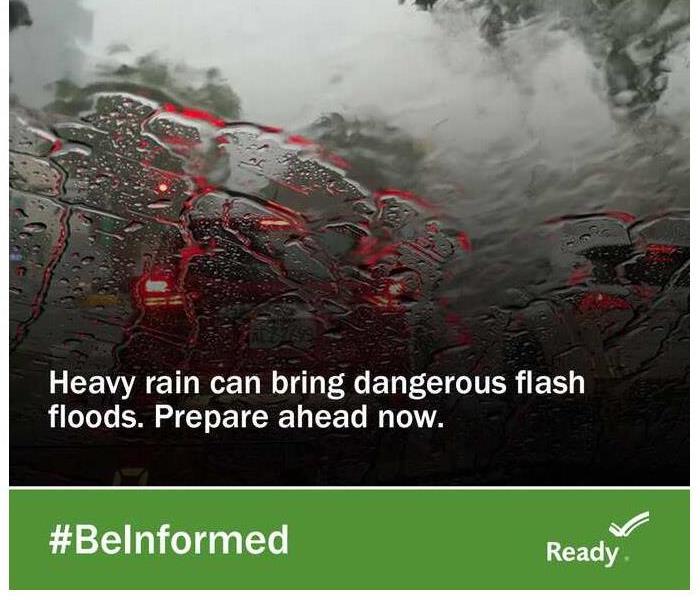 Be prepared for flash flooding
Be prepared for flash flooding
The Summer months are not that far away and it got me thinking about warm weather preparedness..
We think about vacations, going to the beach and just enjoying the hazy days of Summer. We are lucky in the Upper Valley that we don't often have to deal with damaging storms that other parts of the country do.
The Upper Valley has been unfortunate enough to have been stricken with drought conditions and sudden heavy rains the past couple of Summers leading to flash flooding, locally in the Lebanon area where numerous roads were washed away leaving some stranded until the roads could be repaired.
Preparation for the Summer months is just as important as preparing for the Winter months.
So, what can we do to prepare for flooding and sudden Summer storms?
According to ReadyGov flooding is a temporary overflow of water onto land that is normally dry and floods are the most common natural disaster in the United States.
Floods can result from rain, snow ,storms surges and more, floods can develop slowly or quickly. Flash floods come with no warning.
If you are under a flood warning you should find shelter immediately and NEVER drive through or walk through flood waters,6 inches of water can knock you down and 1 foot of water can sweep away your vehicle.
Having the necessary supplies at home is important if you find yourself living on a washed out road and without electricity as we did in Lebanon Two years in a row.
Learn and practice evacuation routes, shelter plans, and flash flood response. Gather supplies, including non-perishable foods, cleaning supplies, medications and water for several days, in case you must leave immediately or if services are cut off in your area.
For information on how you can receive alerts, follow this helpful link: Alerts
Stay safe during the Summer months and remember that SERVPRO is just a phone call if you need us! 603-298-6942 #stayprepared
Ice dams and their prevention
11/17/2021 (Permalink)
Winter sure is closing in here in the northeast! The temperatures are dropping and the frost covers everything at the start of every day.
If you haven't begun your preparations for the Winter season, now, is a perfect time to get started!
This is the time to be extra vigilant when it comes to ice dams at your home or business.
It's all about that roof!
Ice dams occur after a heavy snowfall when warm air in the attic causes the roof to warm and the snow to melt. Water running down the roof refreezes when it reaches the colder roof edge, forming a mound of ice.
The ice traps melt water, which can seep back up under shingles and drip through the roof into your house, causing wet and stained ceilings and walls, and peeling paint and rot.
The easiest way to prevent ice dams is by keeping your roof cold. This means never letting your roof temperature exceed 32 degrees. At 32 degrees, snow starts melting.
Most home and businesses heat loss is through the roof and air leaks caused by unblocked walls, gaps in drywall, and cracks around light fixtures, plumbing pipes, chimneys or heating vents.
Leaks can be very difficult to take care of because that requires that you roll back or rake your insulation back to find and block leaks. Typically using a foam or another method of caulking.
Proper insulation is imperative. You will want to start by making sure to measure your insulation. Building codes require about 12 to 14 in. of fiberglass or cellulose. Add more if you have less than 8 in. and have had ice dam problems in the past.
Blown-in cellulose and fiberglass are usually better than hand-placed batts, because they fill more tightly around rafters, joists and other obstructions, leaving fewer gaps.
Ventilation is important for keeping your roof cold.
Keep the roof cold to minimize ice dams. Upgrade attic insulation to about R-40, plug up air leaks to the attic and improve attic ventilation.
A cold roof isn’t always a perfect solution. During winters with heavy snowfall, you may get ice dams anyway.
Ice dams may consistently form at the foot of roof valleys (the junction where two roofs meet at a right angle), because they fill with windblown snow. And some sections of the roof may be impossible to keep cold. That’s when you have to call on secondary strategies to prevent ice dam damage.
The very first thing that you can do is to make sure the snow is removed from your roof after a heavy snowfall as soon as possible, the longer the snow sits and compacts down, the harder it will be to remove it.
Flash around the chimney
A lot of local small businesses in our area are older renovated homes, where chimneys are prevalent.
Bridge the gap between chimney and house framing with L-shaped steel flashing held in place with unbroken beads of a fire-stop sealant.
Using canned spray foam or insulation isn't fire safe.
Sometimes despite all of your efforts, ice dams occur and with them water damage to your home or business.
SERVPRO of Lebanon/Hanover/Littleton has experienced technicians ready to help if you suffer water damage to your business.
No disaster is too big or small!
Call SERVPRO of Lebanon/Hanover/Littleton today at 603-298-6942.
Hard Water effects on your home
11/12/2021 (Permalink)
Hard water is a fact of life for most of us in the Northeast.
In fact, The stats tell us 85% of homeowners are affected by hard water.
If you were to take a look around your home for signs of hard water, they wouldn't be hard to miss!
When hard water evaporates it leaves behind mineral deposits known as scale. Scale can be found most easily around faucet taps and shower heads. It appears as a White or rusty scale buildup.
Over time, scale buildup can affect your plumbing as well as water dependent appliances.
- If your dishwasher is no longer cleaning dishes as well as it used to, hard water might be the problem. Soap doesn’t lather as well with hard water, diminishing the soap’s effectiveness.
- If you notice your clothes are coming out of the wash looking a little dingy and just not as bright and clean as they should be, is another sign of hard water.
Over time hard water scale buildup forms in your pipes.
It slows the efficiency of your water-using appliances. More energy is required for your water heater to function, and the flow of water to your dishwasher and washing machine slows down.
These deficiencies can lead to higher utility costs.
According to Homewater101
- 29% more energy is used to heat your water during the life of your water heater if you have hard water.
- Over 10 years, it’s estimated your water bill will be $1,500 more if you have hard water.
- The lifespan of home appliances decrease by 30-50%.
If possible, investing in a water softener can help eliminate your hard water problems. But in the meantime there are things that you can do to help with the rust stains and White scale that is left behind.
Keep in mind, none of these things will help with mineral build up in your pipes, but acts as a temporary appearance fix.
For Stains, spots and scale buildup
Apple Cider Vinegar or White Vinegar is a good natural alternative to chemical cleaners if you prefer.
Vinegar’s acidity can cut through the minerals left behind by hard water. Create your own cleaner by mixing a 50–50 solution of distilled water and vinegar to spot-treat scale on shower doors, faucets and around sinks and tubs.
Combine vinegar with baking soda for a more powerful scrub for inside bathtubs and sinks.
If you do not have vinegar, lemon juice is a good alternative!
Again, none of this will help with corrosion to your pipes or the affects that hard water has on your appliances. It's best to speak to a professional regarding this and Water Softener solutions.
If you have an questions or concerns about the effects that water can have on your home; give us a call today at 603-298-6942.
"Like it never even happened."
Who do you call for your water emergencies? SERVPRO
11/8/2021 (Permalink)
Why SERVPRO for your Water disasters?
Because we are Faster To Any Size Disaster and we are a 24 Hour Emergency Service!
Disasters don't happen when it's convenient, but you can rely on us to get there because of our service response guidelines!
Whether it's fire, water or a storm; disasters come in all shapes and sizes!
To learn more about our guidelines and why we're faster to any size disaster, check out our guidelines below.
SERVICE RESPONSE GUIDELINES
Damage of any kind to your business; especially fire, storm or water damage, can be stressful for owners, property managers, employees and tenants.
Property damage, equipment damage, document loss and temporary business closure are just some of the concerns you may experience.
Timely response and thorough mitigation can alleviate these concerns.
The first 24 hours can make the difference between restoring versus replacing your business property and belongings.
SERVPRO of Lebanon/Hanover/Littleton's 1-4-8 Service Response Guidelines can prevent Fire/Water and storm damage from creating long term problems.
- Within 1 hour from notice of loss, a SERVPRO of Lebanon/Hanover/Littleton Professional contacts you to arrange for services.
- Within 4 hours of loss notification, a SERVPRO of Lebanon/Hanover/Littleton professional is on-site to start mitigation services.
- Within 8 business hours of on-site arrival, a verbal briefing of the scope is communicated to the appropriate person.
**Exceptions may apply under certain conditions, such as a local catastrophic event or storm situation which could make getting around dangerous due to downed power lines or flooding.
Have Questions about Fire, Smoke, Storm or Water Damage?
Call Us Today - (603) 298-6942
My basement is flooded, who should I call? SERVPRO!
11/5/2021 (Permalink)
Has your sump pump been running overtime?
it's been a rainy season in the Northeast this year and we have been inundated with flooded basement calls. What can you expect when we arrive?
What are some of the things that SERVPRO can do when I have a flood in my basement?
Flooded Basement dry Out:
- Pump Deep Water
- Carpet Water removal
- Moisture Test walls
- Set up Drying Equipment
- Apply Antimicrobials
- Test Drying Complete
Even if you have an unfinished basement, leaving water or moisture can cause damage to the rest of the structure.
Imagine the condensation that could happen when it's 90* outside.
The concrete or cement blocks used to construct basements are susceptible to mold growth as well as odor.
Imagine all of the exposed framing. Framing lumber does and will absorb moisture and thus, grow mold. The metal framing ties may not be porous enough for mold growth; but they will corrode.
How about the plumbing and wiring?
Again, any metal parts can and most likely will corrode with excess moisture in the air.
The insulation! Perfect for mold growth! Wet insulation is a perfect breeding ground for mold and it affects the performance of the insulation itself. Wet insulations generally needs to be replaced.
So the takeaway here is, Always remove excess water, dry quickly and apply appropriate antimicrobials.
If you have a flooding situation, SERVPRO of Lebanon/Hanover/Littleton are prepared and ready! Call 603-298-6942 24hours a day, 365 days a year! "Like it never even happened."
Water brings MOLD!
11/6/2020 (Permalink)
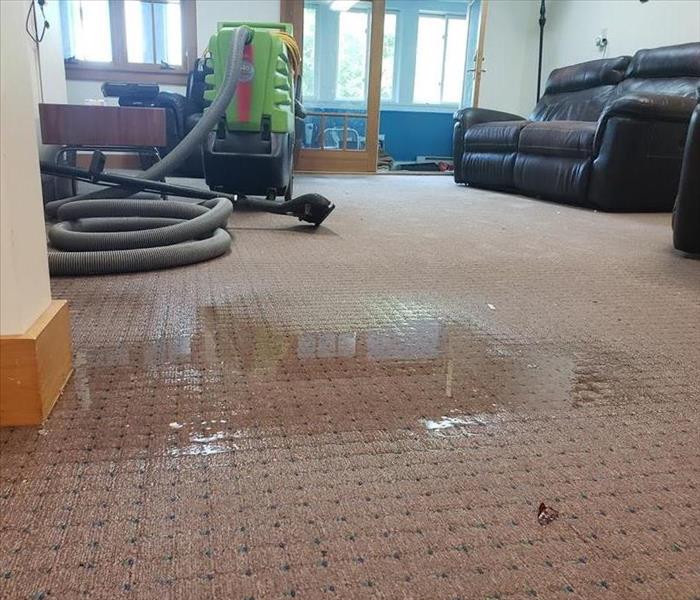 Where there is water, mold isn't far behind!
Where there is water, mold isn't far behind!
Where there is water..There is mold!
Checking for water leaks in your home is imperative to keeping the mold in check. Once mold has taken a hold; damage is not far behind!
How can mold damage your home?
Most people know that household mold can be bad for your health, and it makes an unsightly and bad-smelling mess, but did you know it can cause serious damage to the home, as well? Dealing with household mold quickly, prevents further damage to your home!
Mold damage to household materials and how it affects structures:
- Mold feeds on organic materials, such as wood, paper, many fabrics, and even some types of glue. It literally eats away at these materials, causing them to rot and fall apart.
- Mold can eat away at materials like wallpaper, drywall, carpet, wooden studs in walls, ceiling tiles, floorboards, and other structures inside the home.
- If mold is left to it's own devices, it can lead to rot and literally destroy drywall, wood, ceilings.
Of course, it takes a while to reach that point.
Your house is not going to fall down around you as soon as mold begins to grow in it. Many materials in the home quickly become damaged beyond the point of repair, though, and in time, a home can be completely destroyed by mold growth.
Mold In Heating, Ventilation And Air Conditioning Systems.
Mold can sometimes be found in your heating and air conditioning systems! This can lead to mold spores being blown throughout your home and can lead to mold growth in your duct work.
For this reason, the Federal Emergency Management Agency (FEMA) recommends against turning on your heating or air conditioning if you think there might be mold in your HVAC system.
Have the system inspected, and cleaned if necessary, before turning it on in order to prevent greater mold damage to your home. Note that the Environmental Protection Agency recommends having a professional clean your HVAC ducts, if you do find mold in them, to make sure the job is done correctly and safely.
Each mold infestation requires a particular solution.
Our highly trained professionals use an exacting system of inspection, assessment, containment, air filtration, removing mold infested materials, disinfecting, and cleaning your belongings.
We can perform various types of minor and major repairs.
To save our customers stress, time and costs expense, SERVPRO can handle the entire mold remediation service. We can handle the initial damage mitigation and the rebuilding, including sanitizing and deodorizing of all affected areas.
Our AMRT, Applied Microbial Remediation Technicians, are IICRC CERTIFIED, with advanced corporate and franchise training. We are also experienced in dealing with your insurance company, and we can assist you in these matters if applicable. We can even assist you with your paperwork for your claim.
Call SERVPRO of Lebanon/Hanover/Littleton with any questions that you may have. We are locally owned and operated, we will respond quickly with the help that you need. Call us at (603) 298-6942.
"Like it never even happened."
Let's talk about pipes..
10/26/2020 (Permalink)
The weather is changing now! The cold temperatures are knocking on our door!
When we think about cold weather and how we can plan ahead; one thing often gets overlooked. Our PIPES! A burst pipe can create a big problem.
Let's learn a little about burst pipes..
Some helpful tips on how to protect your pipes from freezing!!
Burst pipes are one of the most common causes of property damage during frigid weather and can cause thousands in water damage—easily $5,000 or more, according to the "Insurance Institute for Business and Home Safety".
Research conducted by the "Building Research Council at the University of Illinois" shows that the “temperature alert threshold” is 20° F, especially if you have uninsulated pipes running through an uninsulated space.
Here are some tips to help you keep those pipes in running order:
- Keep garage doors closed, especially if there are water supply lines in the garage.
- Open kitchen and bathroom cabinet doors to allow warmer air to circulate around the plumbing.
- Let the cold water drip from a faucet served by exposed pipes. Running water through the pipe—even at a trickle—helps prevent pipes from freezing.
- Keep the thermostat set to the same temperature during day and night. Again, during a cold snap is not the time to set back the thermostat at night to save a few bucks on your heating bill.
- If you plan to be away during cold weather, leave the heat on in your home, set to a temperature no lower than 55° F.
- For the long term, add insulation to attics, basements, and crawl spaces. Insulation will maintain higher temperatures in those areas. And to prevent drafts, seal cracks and openings around windows, doors, and at sill plates, where the house rests on its foundation.
Even with all of the preparations,pipes can freeze and burst, leading to water damage. Call SERVPRO of Lebanon/Hanover/Littleton 24hrs a day at 603-298-6942.
Are you dealing water leaks in your business?
10/16/2020 (Permalink)
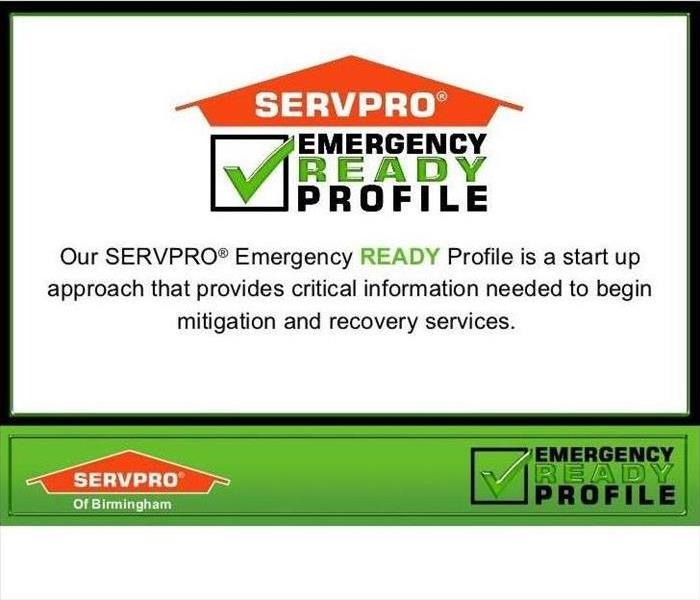 Are you prepared?
Are you prepared?
Disasters can happen at any time. Are you prepared?
Disasters don't always happen when it's convenient; are you and your employees ready for a disaster at any time?
Whether it's during a workday or after work, you and your employees can be Prepared with the SERVPRO Emergency Readiness Program.
The SERVPRO Emergency Ready Profile (ERP) will help ensure you are “Ready for whatever happens” whenever it happens!
In the event of an emergency, the SERVPRO Emergency Readiness Profile, can help minimize business interruption by having an immediate plan of action in place for your facility.
Disasters and emergencies always strike without warning. Preparation is an important key for making it through any size disaster. It is best to plan ahead before any disasters strike.
The SERVPRO Emergency READY Profile (ERP) will help ensure you are "Ready for whatever happens."
In the event of an emergency, the ERP can help minimize business interruption by having an immediate plan of action in place for your facility. The ERP is a comprehensive document containing critical information about your business, including emergency contacts, shut-off valve locations and priority areas.
The ERP also establishes SERVPRO of Lebanon/Hanover/Littleton as your disaster mitigation and restoration provider. The ERP is a no-cost assessment; all it requires is a little time, making it a great value that could save you time and money in the future.
By downloading the free SERVPRO Ready App, this information is stored electronically and can be accessed using your mobile device, making help just a few clicks away.
Preparation is the key to making it through any size disaster, whether it is a small water leak, a large fire or an area flood. Having a plan in place may help minimize the amount of time your business is inactive and get you back in the building following a disaster.
Don't wait until disaster strikes.
Call SERVPRO of Lebanon/Hanover/Littleton at 603.298.6942 to establish your Emergency READY Profile, and be "Ready for whatever happens" in your future.
Tips on how to check for water damage
9/9/2020 (Permalink)
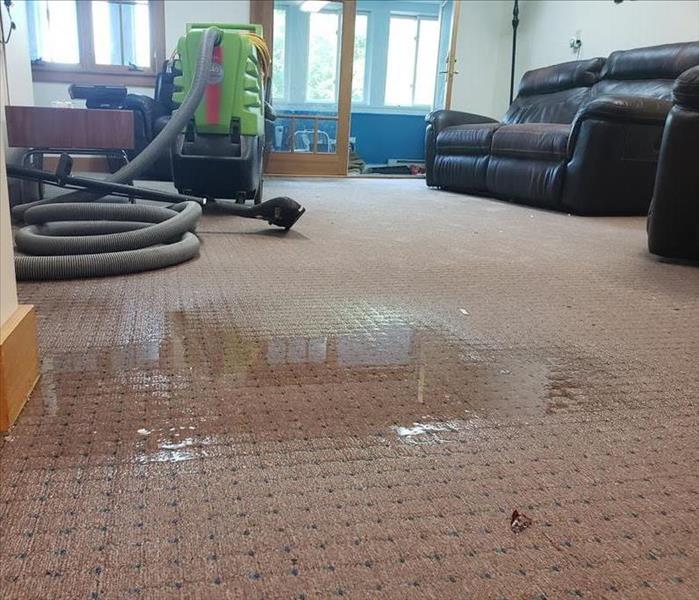 Check for leaks before you have a disaster
Check for leaks before you have a disaster
How to Check your home for Water Damage..
Whether you've just been through a storm or are doing regular maintenance on your home, checking for water is always a good thing! Don't wait until a BIG disaster happens!
Taking the time to complete the steps below periodically; Can save you from that big disaster and will keep that hard earned cash in your pocket!!
Step 1 - Check the Walls
The easiest sign of water damage to spot is water stains on the walls and ceilings. Also check around the window and door frames for stains.
Any unusual stains should be taken seriously, as they could be a sign of a leaky pipe or drain inside the wall. Also look for cracks in the drywall and bubbling under the paint. An area of wall that has been exposed to water can also have a swollen appearance and be soft to the touch.
Step 2 - Check the Floors
Water damage can happen to any type of flooring and can also seep down to the sub floor. Look for any warping or buckling of the floors, especially in the basement. If the floor looks warped, water damage is most likely the cause.
Step 3 - Check the Pipes
Inspect the piping in the kitchen, bathrooms, laundry room, and basement for corrosion around the pipe connections, leaks, or water stains.
Inspect the caulking around the bathroom fixtures. Missing or loose caulking could be caused by water seepage. Look for missing grout or signs of mold. Check the water heater for wet spots on the floor and rust on the tank.
Step 4 - Check the Basement
Basement leakage is a common problem found in houses. Water in the basement often causes damage to the flooring, baseboards, walls, and furniture. Additionally, odors caused by mold and mildew can be unpleasant and even cause health effects.
Inspect for cracks, stains, rust, dampness, mold, and odors.If you have drywall in your basement, Water can wick up it. Check all drywall for signs of water or water stains.
Step 5 - Check the Attic
Check the attic for stains, mold, and other signs of leaks. Pay special attention to the valleys where 2 roof planes come together, the flashing where the roof meets the walls, and the flashing around roof vents and chimneys. The insulation should be dry and in good condition.
Houses located in cold climates can develop ice dams on the roof, which cause water to leak into the attic from melting snow and ice on the roof. Also make sure that attic ventilation is sufficient.
Step 6 - Check the Exterior
Make sure to check the exterior of the house as well. Check the roof for damaged flashing and missing, cracked, or curled shingles.
If you see standing water anywhere outside the home, it could be the sign of a problem. A puddle could be due to poor drainage in the yard, leaky rain gutters, or gutter spouts that don’t take water far enough from the house. The house should be situated on the highest point of the property, with the ground sloping away from the house.
If you see any signs of water damage in your home; call 1-603-298-6942 today. Don't let that small amount of water become a HUGE problem for you!
COMMON CAUSES OF WATER DAMAGE IN YOUR HOME
6/6/2020 (Permalink)
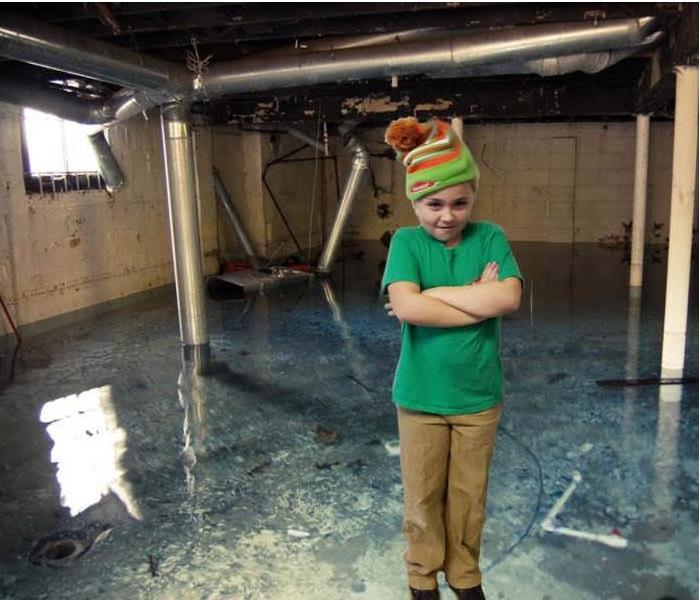 Help! Our basement is flooded
Help! Our basement is flooded
THE 5 MOST COMMON CAUSES OF WATER DAMAGE IN YOUR HOME!
There are so many things that can damage your home. Wind,earthquakes,fires,storms and WATER.
Water Damage being the most frequent of all.
Here are the 5 most common causes of water damage in your home:
Air Conditioner
Your air conditioner might seem to be working just fine, but it’s important to adhere to regular service dates (at least once each year) to ensure nothing is malfunctioning behind the scenes. Your A/C removes moisture from the air, and sometimes that moisture builds up within the A/C itself. If not properly drained, that water could be slowly leaking into your home – potentially ruining the flooring and drywall and, in many cases, introducing mold.
Dishwasher
Dishwashers are another possible culprit of water damage in your home. Your dishwasher can cause water damage if not properly sealed, meaning that the latch is broken, or if it was loaded with the wrong soap. Make sure that any leaks are immediately addressed and that your dishwasher is repaired or replaced ASAP.
Washing Machine
Perform regular checks on your washing machine, inspecting beneath the unit as well as behind it. Make sure all fittings are securely connected, and that the underbelly of the washing machine isn’t leaking any water beneath the unit. If you have an older washing machine that gives you frequent issues, consider replacing it altogether.
Leaking Pipes
It might seem obvious, but water damage in the home is often caused by leaky pipes. Let’s pretend that you have a loose-fitting pipe under the kitchen sink or in the bathroom, and you’ve just recently water pooling in that area. Don’t wait to call a plumber – a leak in one place in your home could signify leaks in other areas, too.
Clogged Drains
Clogged drains aren’t just annoying, they also cause water damage (and mold growth) if left unchecked. If your toilet is clogged, it means that not only can you not use the toilet, but you will likely also experience water backing up into the shower, sinks, or bathroom floor. Sewer water is extremely dangerous because it contains raw sewage and bacteria, and must be cleaned up by a professional.
If your kitchen sink drain is backing up, you can experience sink overflow and subsequent damages to your kitchen flooring and cabinetry. Make sure to seek professional help when experiencing frequent drain clogs so you don’t have to deal with water damage to your home on top of the clog itself.
If you are experiencing leaks in your home Call SERVPRO of Lebanon/Hanover/Littleton today at 603-298-6942.
The BIG THAW in the Upper Valley!
3/4/2020 (Permalink)
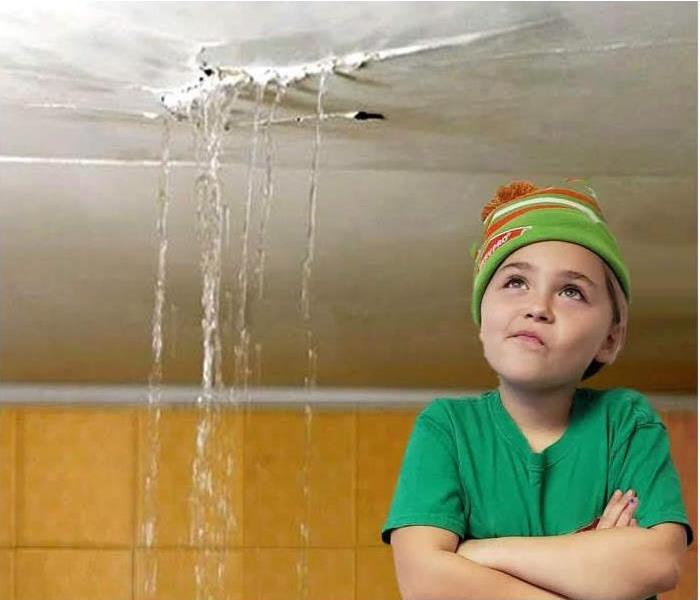 The BIG leak!
The BIG leak!
Skyler Says..
It has been so warm this week and everything is melting!!
When we have warm spells like this and the snow begins to really melt, it is a good time to check those spots that may be susceptible to
leaks!
Check the Basement
Basement leakage is a common problem found in houses. Water in the basement often causes damage to the flooring, baseboards, walls, and
furniture.
Additionally, odors caused by mold and mildew can be unpleasant and even cause health problems. Inspect for cracks, stains, rust,
dampness, mold, and odors.
If you have sheetrock in your basement, check along the bottom edge. Water will wick up your sheetrock.
Check the Attic and Roof
Check the attic for stains, mold, and other signs of leaks. Pay special attention to the valleys where 2 roof planes come together, the flashing where the roof meets the walls, and the flashing around roof vents and chimneys. The insulation should be dry and in good condition.
Houses located in cold climates can develop ice dams on the roof, which cause water to leak into the attic from melting snow and ice on the roof.
Also make sure that attic ventilation is sufficient and is free of any debris.
Check the flooring
Water damage can happen to any type of flooring and can also seep down to the sub flooring.
Look for any warping or buckling of the floors,
especially in the basement. If the floor looks warped, water damage is most likely the cause.
Ensuring that you have good drainage can prevent the weakening of your foundation by preventing standing water that can cause cracks in your foundation, leading to leaking in your basement.
If you see any signs of water damage in your home; call the professionals at SERVPRO of Lebanon/Hanover/Littleton at 1-603-298-6942 today. Don't let that small amount of water become a HUGE problem for you!
"Like it never even happened."
Berlin, N.H. home suffers serious Water Damage
11/4/2019 (Permalink)
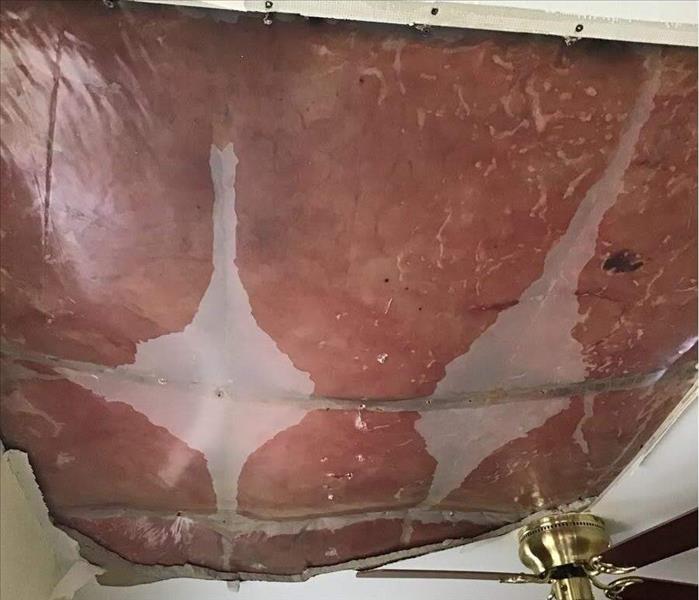 Soaking wet fiberglass insulation
Soaking wet fiberglass insulation
This Berlin home suffered a very significant water loss.
Water leaked through the roof and saturated the insulation in the attic.
With all of the strong winds and rain that we've been having lately in N.H., more homeowners are facing water issues just like this one.
A question we get frequently is, "Is my insulation still effective or able to be saved?"
Let's take a look at the two most common types of insulation:
Cellulose loose-fill
- Cellulose loose-fill, made of pulverized particles of paper and cloth, absorbs a large volume of water and compacts, losing the fluffy characteristics that make it an effective insulator.
- Soaked Cellulose insulation will simply retain water and is very resistant to drying. Generally, wet cellulose is not salvageable and will need to be replaced.
Fiberglass
- Fiberglass AKA "The Pink Stuff" is technically waterproof. Inside an enclosed attic the thick batt retains moisture which degrades its thermal resistance properties.
- Saturated Insulation typically loses at least 40% of its insulating R-value.
Chances are you're going to want to replace the affected insulation because MOLD sets in very quickly.
It is NOT recommended that you attempt to dry the affected area on your own due to the likelihood of contamination by the spread of mold in the drying attempt.
If you are concerned about your insulation or just have some questions, give us a call at 603-298-6942 and we'd be happy to help.
Like it never even happened
Help! Water is everywhere!
11/1/2019 (Permalink)
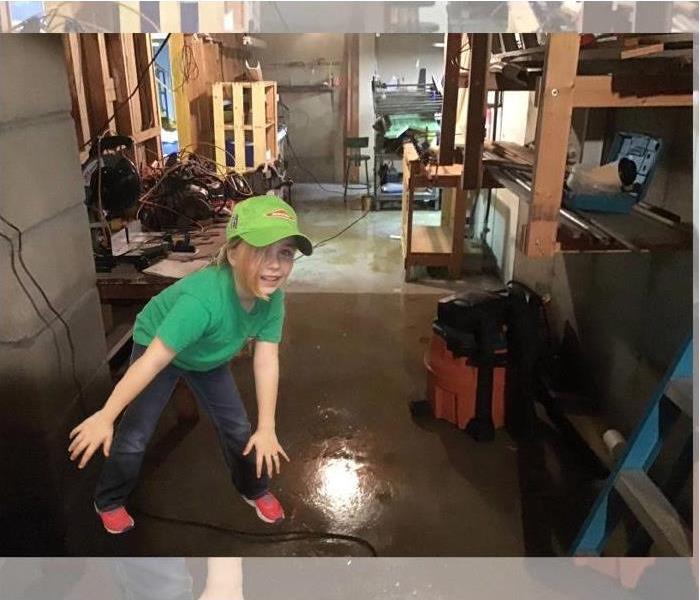 Flooding in the basement!
Flooding in the basement!
Help! Water is everywhere!
A water leak can quickly turn into a flooded area! Whether it's the basement, bathroom or kitchen area; SERVPRO of Lebanon/Hanover/Littleton has the tools to get your area dried out and back to it's predisaster condition.
Here are just a few of the things that SERVPRO can do for you.
- Flooded area Dry Out
- Pump Deep Water
- Moisture Test Walls
- Carpet Water Removal
- Set up Drying Equipment
- Apply Antimicrobials
- Test Drying Complete
- Reconstruction Services
Our highly trained technicians are ready to respond immediately to flood or water damage at your property.
We have the experience, expertise, and training to restore your home or business quickly and efficiently. We use advanced inspection and extraction equipment to find the water and remove it as quickly as possible. Our technicians will monitor and document the drying process to ensure your property is back to normal.
To find out more about SERVPRO of Lebanon/Hanover/Littleton Water Damage Services give us a call at 603-298-6942.
Where there is water, there is mold!
10/25/2019 (Permalink)
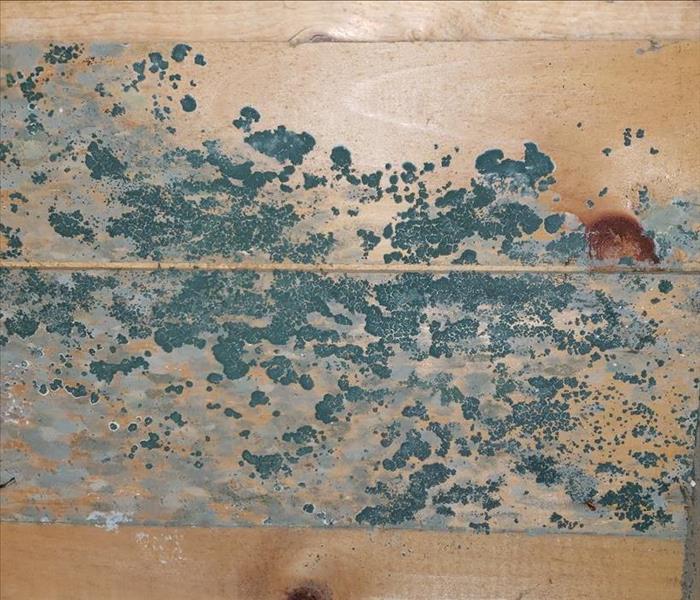 Where there is water, there is mold!
Where there is water, there is mold!
Water leaks are invasive and will spread quickly under flooring and will wick up your sheetrock. The longer water sits, the more time mold has to set in! Once mold has set in, the problem has just become twofold.
So, what is Mold?
Molds are fungi that can be found both indoors and outdoors. Molds grow best in warm, damp, and humid conditions, and spread and reproduce by making spores. Mold spores can survive harsh environmental conditions, such as dry conditions, that do not support normal mold growth.
What you should NOT do if you find mold.
- Do not touch or disturb the mold.
- Do not blow air across any surfaces with visible or suspected mold growth.
- Do not attempt to dry the affected areas yourself.
- Do not spray bleach or any other disinfectant on the mold.
What you should do?
- Stay out of the affected areas and areas you suspect have hidden mold.
- Turn off the HVAC system and the fans.
- Keep humidity levels as low as you can—no higher than 50%–all day long. An air conditioner or dehumidifier will help you keep the level low. Bear in mind that humidity levels change over the course of a day with changes in the moisture in the air and the air temperature, so you will need to check the humidity levels more than once a day.
- Use an air conditioner or a dehumidifier during humid months.
- Be sure the home has adequate ventilation, including exhaust fans.
- Add mold inhibitors to paints before application.
- Clean bathrooms with mold killing products.
- Do not carpet bathrooms and basements.
- Remove or replace previously soaked carpets and upholstery.
Call SERVPRO Lebanon/Hanover/Littleton at 603-298-6942 if you suspect a water leak in your home. We are here to help and make it "Like it never even happened."
Is Water lurking in your home?
10/23/2019 (Permalink)
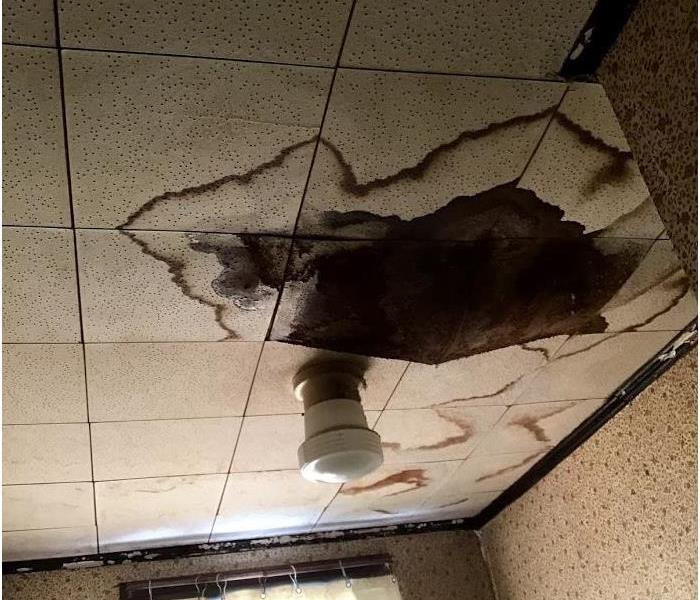 Water damage
Water damage
It doesn't take a lot of water to cause a problem!
Whether it's a slow leak or a burst pipe; water is a destructive force. This Lebanon homes ceiling suffered from a pretty significant water loss and because the leak started upstairs, it was very difficult to detect until the problem was obvious.
Water leaks like this one aren't always easy to detect, but knowing the most common causes of water leaks will give you the upper hand and an idea of just where to look to spot leaks before they become a disaster.
Follow this informative link to learn the 5 most common causes of water damage in your home:Click here
Like it never even happened
How to prevent Ice dams in your Lebanon home!
9/11/2019 (Permalink)
Water damage issues can be a year round problem in New England, but Winter is right around the corner,and that presents it's own set of challenges that homeowners need to deal with.
Ice dams being one!
According to Wikipedia "An ice dam is an ice build-up on the eaves of sloped roofs of heated buildings that results from melting snow under a snow pack reaching the eave and freezing there. Freezing at the eave impedes the drainage of meltwater, which adds to the ice dam and causes backup of the meltwater, which may cause water leakage into the roof and consequent damage to the building and its contents if the water leaks through the roof".
Prevention is the key to tackling this problem and there are precautions that we can take.
- Remove snow from roof using a roof rake.This eliminates a key component in ice dam formation.
- Assure that you have sufficient insulation your roof to prevent freezing at the roof surface under a deep snow pack.
- Make sure to have sufficient ventilation in your attic so that the hot air can escape. This is needed to have a cold roof (below 30 F) to prevent melting.
- Make sure to have plenty of insulation in your attic floor as well. This will minimize the warming of the attic through heat loss of your living space.
- Wherever possible,especially in ceilings; seal possible air leaks. This works in conjunction with the insulation.
- Before Winter strikes, clean those gutters. Keeping them free of debris will allow a place for the melting snow to go.
- Keep some Calcium or Magnesium Chloride on hand. This can be used on an ice dam when you see it starting.
Northeast winters can be really hard on homes and even with all of these precautions, ice dams can happen; and with it comes the potential for water leaking into your home.
If you suspect that you may have water leaking into your home or find evidence of wet insulation, give SERVPRO of Lebanon/Hanover/Littleton a call today at 603-298-6942. We're available 24 hours a day.
Like it never even happened
Can water damaged insulation be saved?
5/13/2019 (Permalink)
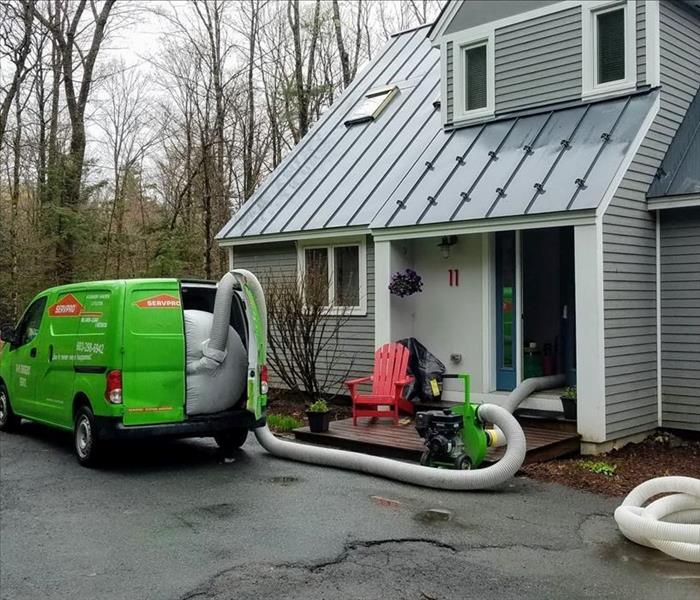 Removing wet insulation
Removing wet insulation
My insulation is wet! Can it be saved??
There are two types of insulation that most homeowners use. These are known as fiberglass batts, AKA "The pink stuff" and blown-in cellulose loose-fill.
Both are susceptible to attic water damage but in two specific ways.
Cellulose loose-fill, made of pulverized particles of paper and cloth, absorbs a large volume of water and compacts, losing the fluffy characteristics that make it an effective insulator.
Soaked Cellulose insulation will simply retain water and is very resistant to drying. Generally, wet cellulose is not salvageable and will need to be replaced.
Fiberglass is technically waterproof, inside an enclosed attic the thick batt retains moisture which degrades its thermal resistance properties.
Saturated insulation typically loses at least 40% of its insulating R-value.
Mold is another thing that should be taken into consideration.
Depending on how long your insulation has been wet; Mold growth may have set in. Be prepared to inspect your insulation before deciding between trying to dry or simply replacing.
Drying a large area of soaked insulation as well as detecting mold is a labor-intensive process that should be left to professionals. Due to the chance of contamination.
Chances are you're going to want to just replace the affected insulation. Mold is quick to grow and spread, leading to a potential health hazard.
If you find evidence of water leaks in your attic, don't hesitate to reach out for help because time is of the essence and mold is not far behind.
SERVPRO of Lebanon/Hanover/Littleton has got you covered! If you have questions regarding water or mold, Give us a call at 603-298-6942!
Spring rains are here!
4/17/2019 (Permalink)
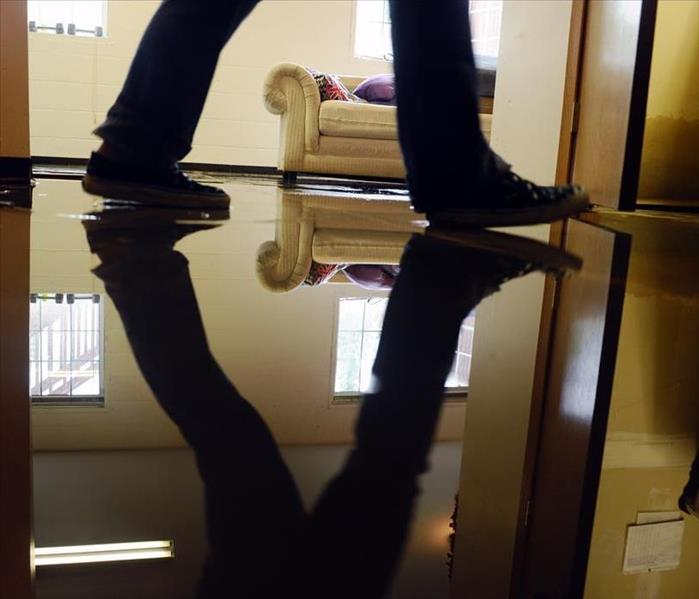 Flooded basement!
Flooded basement!
Spring is officially here in the Northeast and with it comes the big melt!
If you want to avoid a flood in your basement or cellar follow these helpful tips:
To prevent water from leaking through your foundation, look to gutters for your first line of defense.
While gutter-and-downspout systems protect your house from rainwater and snow melt, they can also compound drainage problems by concentrating roof runoff at a house's corners close to the foundation.
To carry water away, attach a sloped leader to each gutter and guide water at least 10 feet from the foundation.
Downspouts can also be directed to dump directly into an above or under ground catch basin which will redistribute the water slowly back into the ground via small holes drilled throughout the basin.
Plug gaps and holes in basement.
If you see water dribbling into the basement through cracks or gaps around plumbing pipes, you can plug the openings yourself with hydraulic cement or polyurethane caulk.
Check your landscaping.
Check that your landscaping isn’t allowing water to pool around your foundation.
Soil should always slope away from your foundation for at least three feet. If the soil around your foundation is level or slopes back toward your home, add enough fresh soil to allow water to flow away and allow at least six inches of clear space between your foundation and your landscaping.
Maintain Your Plumbing.
While most of the hazards that lead to water in the basement come from outside water; water and drain pipes inside your home could also cause an issue. Plumbing maintenance begins with using your drains properly, including sinks, bathtubs, showers, and toilets.
Waterproof the Walls.
Waterproofing the walls is an effective way of keeping rain- and groundwater out of your basement.
You can paint the interior of your basement walls with a waterproofing product, while a professional waterproofing company will need to waterproof the exterior side of your foundation.
Water in your basement can lead to mold growth and that can lead to health concerns!
Be vigilant in checking for water leaks in your home and basement to avoid big water problems in the future!
How to spot water damage
1/2/2019 (Permalink)
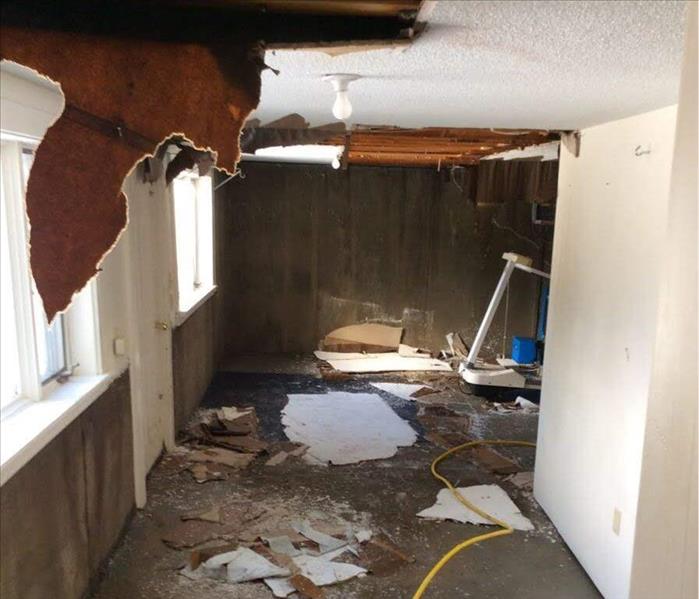 Significant Water damage to home!
Significant Water damage to home!
How to Check your home for Water Damage!
Don't wait until a BIG disaster happens! Taking the time to complete the steps below periodically; Can save you from that big disaster and will keep that hard earned cash in your pocket!!
Step 1 - Check the Walls
The easiest sign of water damage to spot is water stains on the walls and ceilings. Also check around the window and door frames for stains. Any unusual stains should be taken seriously, as they could be a sign of a leaky pipe or drain inside the wall. Also look for cracks in the drywall and bubbling under the paint. An area of wall that has been exposed to water can also have a swollen appearance and be soft to the touch.
Step 2 - Check the Floors
Water damage can happen to any type of flooring and can also seep down to the sub floor. Look for any warping or buckling of the floors, especially in the basement. If the floor looks warped, water damage is most likely the cause.
Step 3 - Check the Pipes
Inspect the piping in the kitchen, bathrooms, laundry room, and basement for corrosion around the pipe connections, leaks, or water stains. Inspect the caulking around the bathroom fixtures. Missing or loose caulking could be caused by water seepage. Look for missing grout or signs of mold. Check the water heater for wet spots on the floor and rust on the tank.
Step 4 - Check the Basement
Basement leakage is a common problem found in houses. Water in the basement often causes damage to the flooring, baseboards, walls, and furniture. Additionally, odors caused by mold and
mildew can be unpleasant and even cause health problems. Inspect for cracks, stains, rust, dampness, mold, and odors.If you have
drywall in your basement, Water can wick up it. Check all drywall for signs of water or water stains.
Step 5 - Check the Attic
Check the attic for stains, mold, and other signs of leaks. Pay special attention to the valleys where 2 roof planes come together, the flashing where the roof meets the walls, and the flashing around roof vents and chimneys. The insulation should be dry and in good condition. Houses located in cold climates can develop ice dams on the roof, which cause water to leak into the
attic from melting snow and ice on the roof. Also make sure that attic ventilation is sufficient.
Step 6 - Check the Exterior
Make sure to check the exterior of the house as well. Check the roof for damaged flashing and missing, cracked, or curled shingles. If you see standing water anywhere outside the home, it
could be the sign of a problem. A puddle could be due to poor drainage in the yard, leaky rain gutters, or gutter spouts that don’t take water far enough from the house. The house should be
situated on the highest point of the property, with the ground sloping away from the house.
If you see any signs of water damage in your home; call the professionals at SERVPRO of Lebanon/Hanover/Littleton at 1-603- 298-6942 today. Don't let that small amount of water become a HUGE problem for you!
The 5 most common causes of water damage in your home
10/31/2018 (Permalink)
There are so many things that can damage your home! Wind,Earthquakes,Fires,Storms and Water.
Water Damage being the most frequent of all!
Here are the 5 most common causes of water damage in your home:
Air Conditioner
Your air conditioner might seem to be working just fine, but it’s important to adhere to regular service dates (at least once each
year) to ensure nothing is malfunctioning behind the scenes. Your A/C removes moisture from the air, and sometimes that moisture builds up within the A/C itself. If not properly drained, that water
could be slowly leaking into your home potentially ruining the flooring and drywall and, in many cases, introducing mold.
Dishwasher
Dishwashers are another possible culprit of water damage in your home. Your dishwasher can cause water damage if not properly sealed, meaning that the latch is broken, or if it was loaded with the wrong soap. Make sure that any leaks are immediately addressed and that your dishwasher is repaired or replaced ASAP.
Washing Machine
Perform regular checks on your washing machine, inspecting beneath the unit as well as behind it. Make sure all fittings are securely connected, and that the underbelly of the washing machine isn’t
leaking any water beneath the unit. If you have an older washing machine that gives you frequent issues, consider replacing it altogether.
Leaking Pipes
It might seem obvious, but water damage in the home is often caused by leaky pipes. Let’s pretend that you have a loose-fitting pipe under the kitchen sink or in the bathroom, and you’ve just recently water pooling in that area. Don’t wait to call a plumber – a leak in one place in your home could signify leaks in other areas, too.
Clogged Drains
Clogged drains aren’t just annoying, they also cause water damage
(and mold growth) if left unchecked. If your toilet is clogged, it means that not only can you not use the toilet, but you will likely also experience water backing up into the shower, sinks, or bathroom floor. Sewer water is extremely dangerous because it contains raw sewage and bacteria, and must be cleaned up by a professional.
If your kitchen sink drain is backing up, you can experience sink overflow and subsequent damages to your kitchen flooring and
cabinetry. Make sure to seek professional help when experiencing frequent drain clogs so you don’t have to deal with water damage to your home on top of the clog itself.
If you are experiencing leaks in your home Call SERVPRO of Lebanon/Hanover/Littleton today at 603-298-6942.
The cold is here! Some tips on how to protect your pipes from freezing!!
10/22/2018 (Permalink)
The weather is changing here in the Northeast and we all have preparations to do before the upcoming snow and plummeting temperatures. Sometimes overlooked, Our pipes!
Burst pipes are one of the most common causes of property damage during frigid weather and can cause thousands in water damage—easily $5,000 or more, according to the "Insurance Institute for Business and Home Safety".
Research conducted by the "Building Research Council at the University of Illinois" shows that the “temperature alert threshold” is 20° F, especially if you have uninsulated pipes running through an uninsulated space.
Here are some tips to help you keep those pipes in running order:
- Keep garage doors closed, especially if there are water supply lines in the garage.
- Open kitchen and bathroom cabinet doors to allow warmer air to circulate around the plumbing.
- Let the cold water drip from a faucet served by exposed pipes. Running water through the pipe—even at a trickle—helps prevent pipes from freezing.
- Keep the thermostat set to the same temperature during day and night. Again, during a cold snap is not the time to set back the thermostat at night to save a few bucks on your heating bill.
- If you plan to be away during cold weather, leave the heat on in your home, set to a temperature no lower than 55° F.
For the long term, add insulation to attics, basements, and crawl spaces. Insulation will maintain higher temperatures in those areas. And to prevent drafts, seal cracks and openings around windows, doors, and at sill plates, where the house rests on its foundation.
Even with all of the preparations,pipes can freeze and burst, leading to water damage. Call SERVPRO of Lebanon/Hanover/Littleton 24hrs a day at 603-298-6942.
How to prevent water damage
9/7/2018 (Permalink)
Whether it's a little water or a lot of water, the damage can be costly!
Protecting your home from water damage!
Ensure Good Drainage. Poor drainage weakens your foundation, causing cracks, uneven settling, and pathways for water to enter your home.
Clean your gutters routinely
A clogged gutter will send cascades of water down the side of your house, damaging your siding and foundation.
Ensure your downspouts direct water 5 to 10 feet away from your house.
Make sure your yard is sloped at least 6 inches over a 10-foot span away from your foundation. That slope keeps water from getting down right next to your foundation, where it could cause walls to lean, crack the masonry, and create leaks. (For crawl spaces, keeping water away makes sure excess water doesn’t pool underneath your floor, making for damp conditions that encourage mold, rot, and insects.)
But don’t let the soil get too dry, either. Long dry spells let the soil around your house dry out and shrink. A big rain may make the soil expand, putting pressure on your foundation walls. In a drought, run a soaker hose at least 6 inches from the foundation and 3 inches under the soil to keep the soil from contracting and expanding.
Test Your Sump Pump Regularly
How to test your sump pump:
Slowly fill the sump pump pit with water. Watch for the “float” (similar to the float in your toilet) to rise, which should turn on the pump. Then watch to make sure the water level falls.
Test your backup pump the same way, but unplug the main pump first.
If you don’t have a backup pump — or a generator — and are on municipal water, get one that runs on water pressure. If you’re on well water, your only option is the battery kind.
Check for Water Leaks and Fix Them.
Persistent leaks lead to mold and mildew, rot, and even termites and carpenter ants (they like chewing soggy wood, since it’s soft). Yet if you fix a leak soon after it starts, there may be no long-term damage at all.
How to check for leaks:
Check for dark spots under pipes inside sink cabinets, stains on ceilings, toilets that rock, and of course drips.
At least once a year, inspect your roof. Repair missing, loose, and damaged shingles. Repair any cracked caulking and check for leaks around flashing.
For more information on water damage and cleanup Click Here
Or contact SERVPRO of Lebanon/Hanover/Littleton at 603.298.6942
There is no such thing as a small disaster!
8/4/2018 (Permalink)
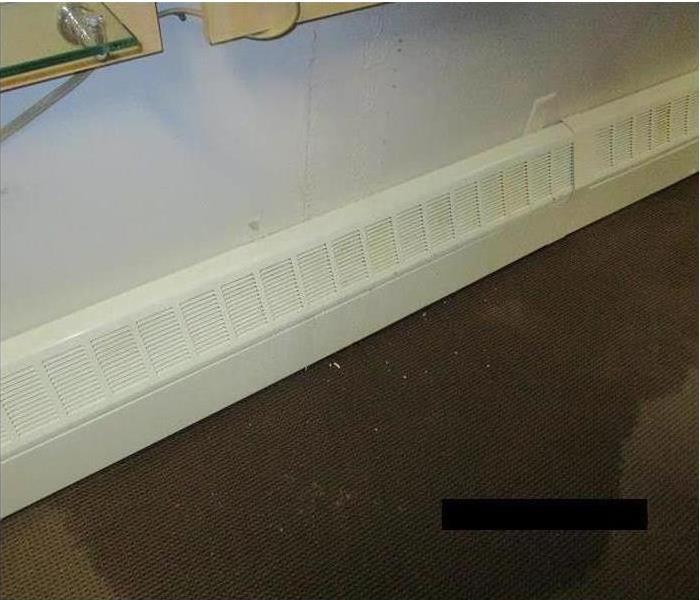 Small water leak
Small water leak
With any leak it's the water you don't see that can cause the most damage!
SERVPRO of Lebanon/Hanover/Littleton will occasionally receive calls from customers with concern and worry about possible mold growth. Upon inspection it will be noted that they had a small water leak "some time ago" that they chose to try and mitigate themselves.
SERVPRO of Lebanon/Hanover/Littleton professionals are trained to safely clean and restore homes and businesses utilizing the following procedures:
•Identify the Source/Type of water
•Measure temperature and humidity for drying analysis
•Survey the extent of damage and inspect the premises for hidden moisture
•Perform emergency water extraction
•Move and block furniture and contents
•Inspect carpet pad/carpet and provide service
•Apply necessary treatments (Disinfectants/Deodorization)
•Utilize advanced drying and monitoring equipment
•Dispose of Refuse
There is NO Such Thing as a SMALL DISASTER!
Especially when a small leak now could blossom into a large claim later. Unseen water can soak through walls, seep through carpet and pool on subfloors, causing major problems over time. Instead of trusting intrained eyes, help ensure the value of your property by calling SERVPRO of Lebanon/Hanover/Littleton.
SERVPRO of Lebanon/Hanover/Littleton professionals have the equipment, training, and experience to find and dry unseen water before secondary damages set in.
To help SMALL LEAKS from becoming BIG PROBLEMS, call SERVPRO of Lebanon/Hanover/Littleton at 603.298.6942
#SERVPROofLebanon/Hanover/Littleton #SERVPRO603 #HereToHelp
Water Damages come in a Variety of ways
6/7/2018 (Permalink)
Water damages come in a Variety of ways
Water damages can happen at any time through out the year. They can happen from any number of different things such as:
- water heaters
- refrigerators/Ice Makers
- toilets
- pipes
- leaky roofs
- floods
- ground water in basement
- dishwashers
- sump pumps
- natural disasters
The dry out and clean up after water damages are important. Here at SERVPRO of Lebanon/Hanover/Littleton we specialize in doing just that. Our technicians are IICRC certified to safely dry, clean and restore your home or business, using the following procedures:
- Identify the source/type of water-where the problem is
- Measure temperature and humidity for drying analysis
- Survey the extent of the damage and Inspect the premises fir hidden moisture.
- Perform emergency water extraction
- Move and Block furniture & contents
- Inspect carpet pad/carpet and provide services
- Apply necessary treatments (disinfectants/deodorization)
- Utilize advanced drying and monitoring equipment
- Dispose of refuse
Water damages are a problem no matter how small they might seem. Water can soak through walls, and carpet causing problems over time. Here at SERVPRO of Lebanon/Hanover/Littleton, our technicians have monitoring tools to detect water damages that may not be in plain sight.
With any water damage, there is a risk for MOLD. It’s important that water is quickly removed and properly dried, ventilated and disinfected to inhibit the growth of bacteria.
If you have a water damage and are unsure of what to do Click here for more information!
#SERVPROofLebanon/Hanover/Littleton #SERVPRO603 #HereToHelp
AVOID WATER DAMAGE FROM ROOF LEAKS!
3/27/2018 (Permalink)
- Have a professional roofing company inspect your roof if it is aging. Identify concerns such as dislodged, missing or curling shingles. These are signs of a compromised roof that may be susceptible to leaking and winter water damage.
- Monitor the trees surrounding your property. Icy branches or ones bogged down by heavy snow are a damage risk to your roof and property.
- Don’t let anyone clear your roof from snow. We witnessed many fly-by-night “companies” damage roofs while trying to clear the roofs of ice dams and snow. Hire a company that are professional, established and properly insured.
Winter Water Damage Summary
Frozen pipes, ice dams and roof leaks are the leading causes of winter water damage in New England. Following the tips listed here should help avoid the need for costly water damage repairs. In the event of a winter water damage emergency, know that there are professionals available to help. SERVPRO of Lebanon/Hanover/Littleton specializes in helping families and business recover from property disaster. This includes water damage from leaking roofs and burst pipes. SERVPRO of Lebanon/Littleton/Hanover works with all local and national insurance companies and specializes in property damage claims.
To learn more about what to do until SERVPRO of Lebanon/Hanover/Littleton help arrives click here.
#SERVPROofLebanon/Hanover/Littleton #SERVPRO603 #HereToHelp
Broken Water Pipes
1/30/2018 (Permalink)
Here in New Hampshire and Vermont we are, or should be used to the fluctuating temperatures.
During extreme cold, which we have recently experienced much of, water freezes. Even water in your pipes throughout your home. When water freezes, it expands, which builds pressure. When the pressure is to great, the pip will burst, causing water to go everywhere!!
Here are a few tips on keeping pipes thawed in during the cold weather:
- Letting faucets drip. Although it may not stop pipes from freezing it will help the flow, which will help keep pipes from bursting.
- Store hoses inside, when possible.
- If you notice a frozen pipe, you can use a hair dryer, heating pad, hot wash clothes, or space heaters to help thaw them.
Here are 4 Signs that you have a frozen pipe:
- Temperature- water tends to freeze with temperatures 32 degrees and lower.
- Frost- If you can see frost on your pipes
- No water- If you have little or no water coming from a faucet, chances are your pipe is frozen.
- Smell- If there are odd odors coming from the faucet or the drain.
What can you do if your pipes burst:
- Shut off water- Make sure to shut water off from the main shut off, not just the location
- Electricity- Sometimes it is best if you shut off the electricity as well.
- Call a plumber
- Remove water-If you are able to, or call SERVPRO
Here at SERVPRO Lebanon/Hanover/Littleton we are certified to help, and make it "Like it never even happened." For more information Click here
#SERVPROofLebanon/Hanover/Littleton #SERVPRO603 #HereToHelp
IT DOESN’T TAKE A LOT OF WATER TO CAUSE PROBLEMS!
10/23/2017 (Permalink)
IT DOESN’T TAKE A LOT OF WATER TO CAUSE PROBLEMS!
It doesn’t take a lot of water to cause tremendous damage. Just an inch or two can destroy carpets and dry wall, warp wood floors, damage building components.
Water damage can be caused by many things:
- Sump pumps
- Water heater failures
- Broken pipes
- Washing machine
- Dishwasher leaks
- Ice maker problems
- Flooding due to heavy rain
- Ground water seeping into the basement
- Natural disasters
Even after the water seems to disappear, excess moisture can hide in your floor coverings, foundation, wood structures and walls—causing major damage to your property and creating the perfect environment for mold and other fungi growth.
But if you catch it in time, you can ward off a lot of the damage and save money and headaches down the road. It’s important that water is quickly removed and the property dried, ventilated and disinfected to inhibit the growth of bacteria, fungi, mildew and other microorganisms that are harmful.
To learn more about what to do until SERVPRO of Lebanon/Hanover/Littleton help arrives VISIT OUR TIPS PAGE.
#SERVPROofLebanon/Hanover/Littleton #SERVPRO603 #HereToHelp
RESTORING YOUR BUSINESS
9/20/2017 (Permalink)
RESTORING YOUR BUSINESS AFTER A WATER DAMAGE!
Flooding, storms, broken or frozen pipes, sprinkler system mishaps, can all cause numerous issues that require knowledgeable and quick response. We understand that every minute spent mitigating a loss is a minute of lost revenue and productivity. Our IICRC certified technicians are trained to be mindful of legal and environmental concerns, we work quickly to assess each situation and isolate the damaged area. SERVPRO of Lebanon/Hanover/Littleton strive to fully restore the damaged area as quickly as possible, to get your business back up and running as quickly as possible.
If your business happens to suffer any intrusion of water, call the professionals of SERVPRO of Lebanon/Hanover/Littleton. Rest assured our staff is equipped with the knowledge and tools to fully restore your facility.
To learn more about what to do until SERVPRO of Lebanon/Hanover/Littleton help arrives click here
#SERVPROofLebanon/Hanover/Littleton #SERVPRO603 #HereToHelp
FLOODED BASEMENT IN THE UPPER VALLEY!!
8/14/2017 (Permalink)
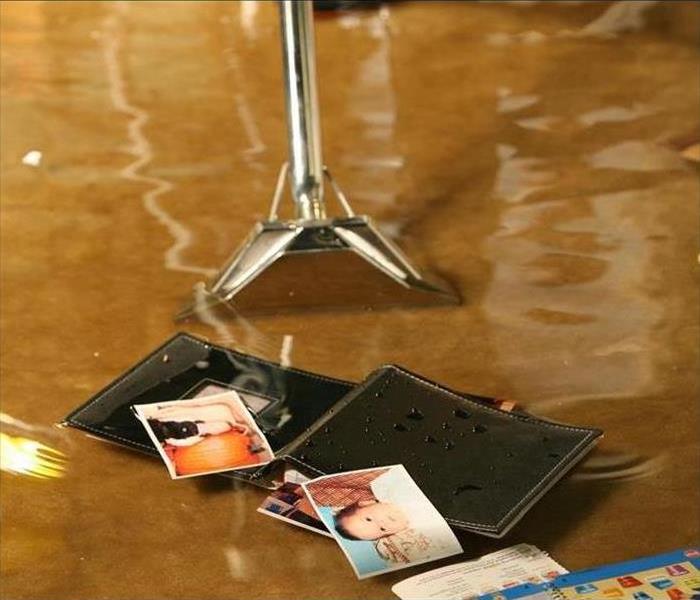 Flooded Basement
Flooded Basement
HELP!
My basement is flooded.
What are some of the things SERVPRO can do when I have a flood in my basement?
Flooded Basement Dry Out:
•Pump Deep Water
•Carpet Water Removal
•Moisture Test Walls
•Set up Drying Equipment
•Apply Antimicrobials
•Test Drying Complete
Even if you have an unfinished basement, leaving water or moisture can cause damage to the rest of the structure. Imagine the condensation that could happen when it’s 90* outside. The concrete or cement blocks used to construct basements are susceptible to mold growth as well as odor. Imagine all of the exposed framing. Framing lumber does and will absorb moisture and thus, grow mold. The metal framing ties may not be porous for mold growth but they will corrode. How about the plumbing and wiring? Again, any metal parts can and probably will corrode with excess moisture in the air. The insulation! Perfect for mold growth.
Our highly trained technicians are ready to respond immediately to flood or water damage at your property. We have the experience, expertise, and training to restore your home or business quickly and properly. We use advanced inspection and extraction equipment to find the water and remove it as quickly as possible. Our technicians will monitor and document the drying process to ensure your property is back to normal.
To find out more about SERVPRO of Lebanon/Hanover/Littleton Water Damage Services Click Here.
THERE IS NO SUCH THING AS A SMALL DISASTER!
6/5/2017 (Permalink)
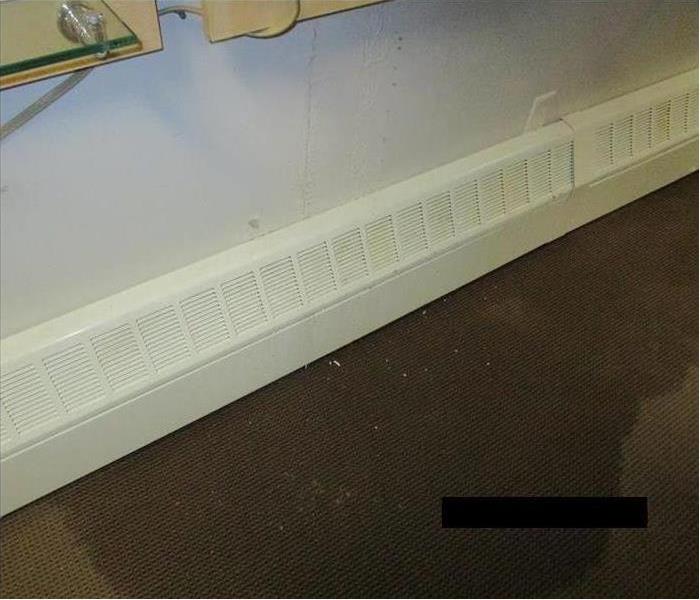 Small Water loss!
#SERVPROofLebanon/Hanover/Littleton #SERVPRO603 #HereToHelp
Small Water loss!
#SERVPROofLebanon/Hanover/Littleton #SERVPRO603 #HereToHelp
SERVPRO of Lebanon/Hanover/Littleton will occasionally receive calls from customers with concern and worry about possible mold growth. Upon inspection it will be noted that they had a small water leak "some time ago" that they chose to try and mitigate themselves.
With any leak it's the water you don't see that can cause the most damage!
SERVPRO of Lebanon/Hanover/Littleton professionals are trained to safely clean and restore homes and businesses utilizing the following procedures:
•Identify the Source/Type of water
•Measure temperature and humidity for drying analysis
•Survey the extent of damage and inspect the premises for hidden moisture
•Perform emergency water extraction
•Move and block furniture and contents
•Inspect carpet pad/carpet and provide service
•Apply necessary treatments (Disinfectants/Deodorization)
•Utilize advanced drying and monitoring equipment
•Dispose of Refuse
There is NO Such Thing as a SMALL DISASTER!
Especially when a small leak now could blossom into a large claim later. Unseen water can soak through walls, seep through carpet and pool on subfloors, causing major problems over time. Instead of trusting intrained eyes, help ensure the value of your property by calling SERVPRO of Lebanon/Hanover/Littleton.
SERVPRO of Lebanon/Hanover/Littleton professionals have the equipment, training, and experience to find and dry unseen water before secondary damages set in.
To help SMALL LEAKS from becoming BIG PROBLEMS, call SERVPRO of Lebanon/Hanover/Littleton at 603.298.6942
#SERVPROofLebanon/Hanover/Littleton #SERVPRO603 #HereToHelp
WINTER WATER DAMAGE TIPS!
1/24/2017 (Permalink)
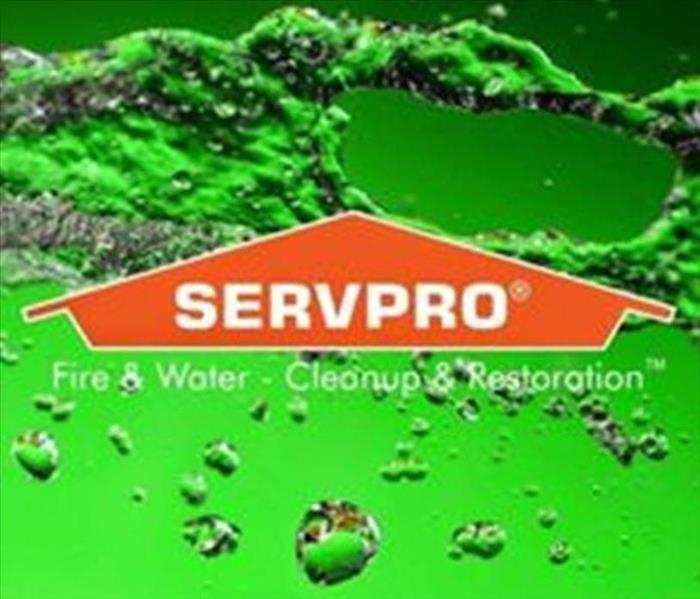 SERVPRO
SERVPRO
WINTER WATER DAMAGE TIPS!
New England winters can be harsh. We witnessed this first hand in 2015 where record cold and snowfall pummeled the majority of the Upper Valley. You know it was a tough winter when “ice dams” and “frozen pipes” become a mainstream topic of discussion around the office water cooler. Nevertheless, we hardy New Englanders persevere despite the winter circumstances. With that said, we also think it wise to be a little more prepared for what may lay ahead.
Winter water damage and insurance claims go hand-in-hand. According to the Insurance Information Institute winter storms in the United States caused $1.9 billion in insurance losses in 2013. In 2014, the number expanded to $2.3 billion, and even higher in 2015. What does this mean for residents in New England? Harsh storms and winter water damage are not going away. Below are a few tips to help prevent and deal with property damages during the coldest season of the year.
Prevent Water Damage from Frozen Pipes
- Know where your water main shut off valve is
- Properly insulate pipes that have exposure to cold environments in your home, such as crawl space
- Maintain adequate interior temperatures in the property. Many sources recommend a minimum of 55-65 degrees. Remember pipes running in an exterior wall will have even a colder environment.
- Open cabinet doors under sinks to allow for heat to circulate underneath.
- During extreme cold, open faucet slightly to allow for a slow drip.
Inhibit Water Damage from Ice Dams
- Maintain clean gutters. Clogged gutters are more susceptible for ice accumulation that may creep up to the roof shingles.
- Safely and carefully clear snow from roof when possible with a snow rake and extension pole.
- Safely and carefully creat channels in exsisting ice dams for snow melt to run off.
- Have a professional energy audit of your home. This will help determine where the excessive heat loss is occurring. The heat loss is one of the primary factors causing the ice dams.
To learn more about what to do until SERVPRO of Lebanon/Hanover/Littleton help arrives click here
#SERVPROofLebanon/Hanover/Littleton #SERVPRO603 #HereToHelp






 24/7 Emergency Service
24/7 Emergency Service














